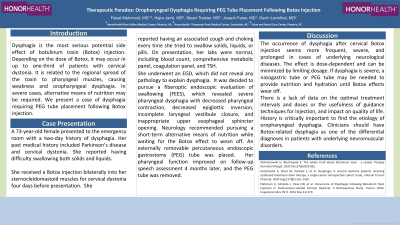Monday Poster Session
Category: Esophagus
P2282 - Therapeutic Paradox: Oropharyngeal Dysphagia Requiring Percutaneous Endoscopic Gastrostomy Tube Placement Following Botox Injection
Monday, October 28, 2024
10:30 AM - 4:00 PM ET
Location: Exhibit Hall E

Has Audio
- FM
Faisal Mehmood, MD
HonorHealth
Scottsdale, AZ
Presenting Author(s)
Faisal Mehmood, MD1, Hajra Jamil, MD2, Stuart Triester, MD1, Joseph Fares, MD1, Gavin Levinthal, MD1
1HonorHealth, Scottsdale, AZ; 2Services Institute of Medical Sciences, Lahore, Punjab, Pakistan
Introduction: Dysphagia is the most serious potential side effect of botulinum toxin (Botox) injection. Depending on the dose of Botox, it may occur in up to one-third of patients with cervical dystonia. It is related to the regional spread of the toxin to pharyngeal muscles, causing weakness and oropharyngeal dysphagia. In severe cases, alternative means of nutrition may be required. We present a case of dysphagia requiring PEG tube placement following Botox injection.
Case Description/Methods: A 73-year-old female presented to the emergency room with a two-day history of dysphagia. Her past medical history included Parkinson’s disease and cervical dystonia. She reported having difficulty swallowing both solids and liquids. She received a Botox injection bilaterally into her sternocleidomastoid muscles for cervical dystonia four days before presentation. She reported having an associated cough and choking every time she tried to swallow solids, liquids, or pills.
On presentation, her labs were normal, including blood count, comprehensive metabolic panel, coagulation panel, and TSH. She underwent esophagogastroduodenoscopy (EGD), which did not reveal any pathology to explain dysphagia. It was decided to pursue a fiberoptic endoscopic evaluation of swallowing (FEES), which revealed severe pharyngeal dysphagia with decreased pharyngeal contraction, decreased epiglottic inversion, incomplete laryngeal vestibule closure, and inappropriate upper esophageal sphincter opening. Neurology recommended pursuing a short-term alternative means of nutrition while waiting for the Botox effect to wean off. An externally removable percutaneous endoscopic gastrostomy (PEG) tube was placed. Her pharyngeal function improved on follow-up speech assessment 4 months later, and the PEG tube was removed.
Discussion: The occurrence of dysphagia after cervical Botox injection seems more frequent, severe, and prolonged in cases of underlying neurological diseases. The effect is dose-dependent and can be minimized by limiting dosage. If dysphagia is severe, a nasogastric tube or PEG tube may be needed to provide nutrition and hydration until Botox effects wear off. There is a lack of data on the optimal treatment intervals and doses or the usefulness of guidance techniques for injection, and impact on quality of life. History is critically important to find the etiology of oropharyngeal dysphagia. Clinicians should have Botox-related dysphagia as one of the differential diagnoses in patients with underlying neuromuscular disorders.
Disclosures:
Faisal Mehmood, MD1, Hajra Jamil, MD2, Stuart Triester, MD1, Joseph Fares, MD1, Gavin Levinthal, MD1. P2282 - Therapeutic Paradox: Oropharyngeal Dysphagia Requiring Percutaneous Endoscopic Gastrostomy Tube Placement Following Botox Injection, ACG 2024 Annual Scientific Meeting Abstracts. Philadelphia, PA: American College of Gastroenterology.
1HonorHealth, Scottsdale, AZ; 2Services Institute of Medical Sciences, Lahore, Punjab, Pakistan
Introduction: Dysphagia is the most serious potential side effect of botulinum toxin (Botox) injection. Depending on the dose of Botox, it may occur in up to one-third of patients with cervical dystonia. It is related to the regional spread of the toxin to pharyngeal muscles, causing weakness and oropharyngeal dysphagia. In severe cases, alternative means of nutrition may be required. We present a case of dysphagia requiring PEG tube placement following Botox injection.
Case Description/Methods: A 73-year-old female presented to the emergency room with a two-day history of dysphagia. Her past medical history included Parkinson’s disease and cervical dystonia. She reported having difficulty swallowing both solids and liquids. She received a Botox injection bilaterally into her sternocleidomastoid muscles for cervical dystonia four days before presentation. She reported having an associated cough and choking every time she tried to swallow solids, liquids, or pills.
On presentation, her labs were normal, including blood count, comprehensive metabolic panel, coagulation panel, and TSH. She underwent esophagogastroduodenoscopy (EGD), which did not reveal any pathology to explain dysphagia. It was decided to pursue a fiberoptic endoscopic evaluation of swallowing (FEES), which revealed severe pharyngeal dysphagia with decreased pharyngeal contraction, decreased epiglottic inversion, incomplete laryngeal vestibule closure, and inappropriate upper esophageal sphincter opening. Neurology recommended pursuing a short-term alternative means of nutrition while waiting for the Botox effect to wean off. An externally removable percutaneous endoscopic gastrostomy (PEG) tube was placed. Her pharyngeal function improved on follow-up speech assessment 4 months later, and the PEG tube was removed.
Discussion: The occurrence of dysphagia after cervical Botox injection seems more frequent, severe, and prolonged in cases of underlying neurological diseases. The effect is dose-dependent and can be minimized by limiting dosage. If dysphagia is severe, a nasogastric tube or PEG tube may be needed to provide nutrition and hydration until Botox effects wear off. There is a lack of data on the optimal treatment intervals and doses or the usefulness of guidance techniques for injection, and impact on quality of life. History is critically important to find the etiology of oropharyngeal dysphagia. Clinicians should have Botox-related dysphagia as one of the differential diagnoses in patients with underlying neuromuscular disorders.
Disclosures:
Faisal Mehmood indicated no relevant financial relationships.
Hajra Jamil indicated no relevant financial relationships.
Stuart Triester indicated no relevant financial relationships.
Joseph Fares indicated no relevant financial relationships.
Gavin Levinthal indicated no relevant financial relationships.
Faisal Mehmood, MD1, Hajra Jamil, MD2, Stuart Triester, MD1, Joseph Fares, MD1, Gavin Levinthal, MD1. P2282 - Therapeutic Paradox: Oropharyngeal Dysphagia Requiring Percutaneous Endoscopic Gastrostomy Tube Placement Following Botox Injection, ACG 2024 Annual Scientific Meeting Abstracts. Philadelphia, PA: American College of Gastroenterology.
